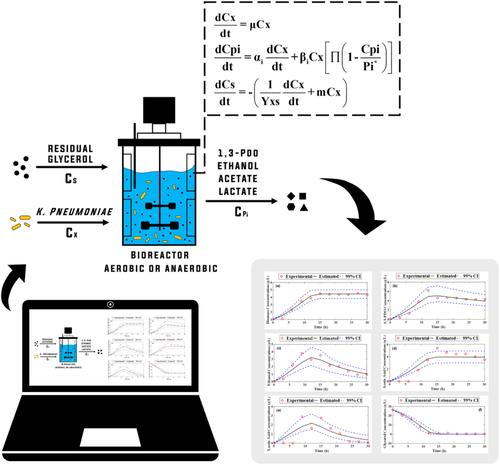当前位置:
X-MOL 学术
›
Biotechnol. Bioeng.
›
论文详情
Our official English website, www.x-mol.net, welcomes your
feedback! (Note: you will need to create a separate account there.)
Mathematical Modeling and Simulation of 1,3‐Propanediol Production by Klebsiella pneumoniae BLh‐1 in a Batch Bioreactor Using Bayesian Statistics
Biotechnology and Bioengineering ( IF 3.5 ) Pub Date : 2024-11-08 , DOI: 10.1002/bit.28883 Nathalia Lobato Moraes, Mailson Batista de Vilhena, Daniele Misturini Rossi, Bruno Marques Viegas
Biotechnology and Bioengineering ( IF 3.5 ) Pub Date : 2024-11-08 , DOI: 10.1002/bit.28883 Nathalia Lobato Moraes, Mailson Batista de Vilhena, Daniele Misturini Rossi, Bruno Marques Viegas

|
Mathematical modeling and computer simulation are fundamental for optimizing biotechnological processes, enabling cost reduction and scalability, thereby driving advancements in the bioindustry. In this work, mathematical modeling and estimation of fermentative kinetic parameters were carried out to produce 1,3‐propanediol (1,3‐PDO) from residual glycerol and Klebsiella pneumoniae BLh‐1. The Markov chain Monte Carlo method, using the Metropolis‐Hastings algorithm, was applied to experimental data from a batch bioreactor under aerobic and anaerobic conditions. Sensitivity analysis and parameter evolution studies were conducted. The root‐mean‐square error (rRMSE) was chosen as the validation and calibration metric for the developed mathematical model. The results indicated that the average tolerance of glycerol was 174.68 and 44.85 g L−1 , the inhibitory products was 150.95 g L−1 for ethanol and 35.56 g L−1 for 1,3‐PDO, and the maximum specific rate of cell growth was 0.189 and 0.275 h−1 , for aerobic and anaerobic cultures, respectively. The model presented excellent fits in both crops, with rRMSE values between 0.09 − 33.74% and 3.58 − 31.82%, for the aerobic and anaerobic environment, respectively. With this, it was possible to evaluate and extract relevant information for a better understanding and control of the bioprocess.
中文翻译:

使用贝叶斯统计对肺炎克雷伯菌 BLh-1 在间歇式生物反应器中生产 1,3-丙二醇的数学建模和模拟
数学建模和计算机模拟是优化生物技术流程的基础,可以降低成本和实现可扩展性,从而推动生物行业的进步。在这项工作中,进行了发酵动力学参数的数学建模和估计,以从残留甘油和肺炎克雷伯菌 BLh-1 中产生 1,3-丙二醇 (1,3-PDO)。使用 Metropolis-Hastings 算法的马尔可夫链蒙特卡洛方法应用于在好氧和厌氧条件下来自间歇生物反应器的实验数据。进行敏感性分析和参数进化研究。均方根误差 (rRMSE) 被选为所开发数学模型的验证和校准指标。结果表明,甘油的平均耐受性为 174.68 和 44.85 g L-1,对乙醇的抑制产物为 150.95 g L-1,对 1,3-PDO 的抑制产物为 35.56 g L-1,最大细胞生长比速率为 0.189 和 0.275 h-1,需氧和厌氧培养。该模型在两种作物中都表现出极好的拟合度,在好氧和厌氧环境中的 rRMSE 值分别在 0.09 − 33.74% 和 3.58 − 31.82% 之间。这样,就可以评估和提取相关信息,以便更好地了解和控制生物过程。
更新日期:2024-11-08
中文翻译:

使用贝叶斯统计对肺炎克雷伯菌 BLh-1 在间歇式生物反应器中生产 1,3-丙二醇的数学建模和模拟
数学建模和计算机模拟是优化生物技术流程的基础,可以降低成本和实现可扩展性,从而推动生物行业的进步。在这项工作中,进行了发酵动力学参数的数学建模和估计,以从残留甘油和肺炎克雷伯菌 BLh-1 中产生 1,3-丙二醇 (1,3-PDO)。使用 Metropolis-Hastings 算法的马尔可夫链蒙特卡洛方法应用于在好氧和厌氧条件下来自间歇生物反应器的实验数据。进行敏感性分析和参数进化研究。均方根误差 (rRMSE) 被选为所开发数学模型的验证和校准指标。结果表明,甘油的平均耐受性为 174.68 和 44.85 g L-1,对乙醇的抑制产物为 150.95 g L-1,对 1,3-PDO 的抑制产物为 35.56 g L-1,最大细胞生长比速率为 0.189 和 0.275 h-1,需氧和厌氧培养。该模型在两种作物中都表现出极好的拟合度,在好氧和厌氧环境中的 rRMSE 值分别在 0.09 − 33.74% 和 3.58 − 31.82% 之间。这样,就可以评估和提取相关信息,以便更好地了解和控制生物过程。






























 京公网安备 11010802027423号
京公网安备 11010802027423号